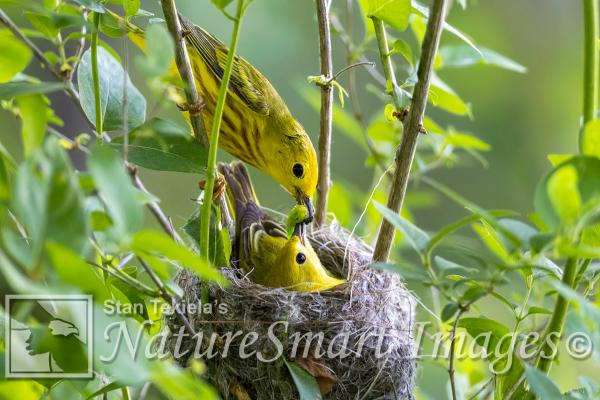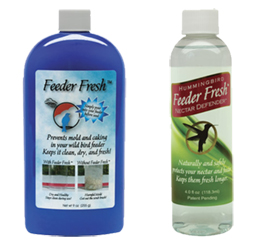View all of the titles in the
NatureSmart Bookstore

by Stan Tekiela
© NatureSmart
September 6, 2022
Sitting alone in a small dark blind waiting for a bird is a wonderful time to reflect or think deeply about all the wonderful and amazing aspects of nature. This happened a couple days ago when I was sitting in one of my ground blinds that I set up to photograph a tiny and delicate yellow bird, the Yellow Warbler (Setophaga petechia).
A week before, while taking a walk (exercising), I saw a small yet familiar bird building a nest in a low shrub. I took note of the location and stopped back a couple days later only to find that the nest these warblers had started was gone. No sign of it at all. I assume that a raccoon tore it down or heavy rains stripped it from the branches. Knowing that this is fairly common occurrence I didn’t worry too much and started looking around the area for another nest. It didn’t take long, and I located the new nest location.
It was in a perfect location for photographing. Slightly downhill from an open flat spot where I could set up my photo blind. I quickly set up my blind as to not disturb or upset the pair as they were busy bringing in nesting material. The female does most of the nest building. I could see that most of the nest was complete and therefore knew egg laying would soon take place.
A few days later I stopped back to check on progress and found four tiny eggs in the nest. The female was incubating the eggs. I slipped into my blind and watched as the male would bring food to the female. This kind of behavior is not well known or well documented. Usually, the female would leave the nest and go out to find food for herself. This would also allow her to exercise her wings and defecate away from the nest site. But with this pair, the male was actively feeding the female on the nest.
The Yellow Warbler is one of the most common and widespread of the New World Warblers. They nest in nearly the entirety of the United States. They winter in the Caribbean, Central America and upper parts of South America. They build a small cup nest weaved of thin strong plant fibers. Most nests are built about 3 to 5 feet above the ground.
It wasn’t long and the eggs hatched and four super tiny, naked, blind, baby birds lay in the bottom of the nest. The female spent many hours sitting on the newly hatched birds to keep them warm. The male was busy bringing in small insect meals for the chicks. Yellow Warblers eat a lot of small caterpillars. Over half of their diet is made up of caterpillars. Which is interesting because their Genus name Setophaga is Greek and breaks down to ses, “moth” and phagos, “eating”. So, they are moth eaters in both the caterpillar stage and also the adult moth stage.
The clutch of eggs is usually 3-6, typically 4-5. It takes only 11-14 days for the eggs to hatch which is incredibly quick. The newly hatched nestlings grow so quickly and are ready to leave the nest in 11-12 days. This means that in less than 2 weeks the baby bird goes from being naked, eyes still closed and unable to care for itself to being able to fly and follow their parents around. Truly amazing.
The parents feed the young even after they leave the nest. The young birds flit around, and the parents find them to deliver insect meals. Only 3 to 4 weeks after hatching the young Yellow Warblers are completely on their own. And you thought you had a rough childhood!
At only one year of age, Yellow Warblers are sexually mature and starting to breed. They are highly migratory and move out of most of the states at the end of summer and spend their winters in warmer climates of the Caribbean and Central America.
Fortunately, the adults and young return to the area they were hatched. When they return, they will search for a mate and an open territory to start the process all over again. I am hoping to find them nesting again next year. Until next time…
Stan Tekiela is an author / naturalist and wildlife photographer who travels the U.S. to study and capture images of wildlife. He can be followed on Instagram, Facebook and Twitter. He can be contacted via his web page at naturesmart.com.
The nationally syndicated NatureSmart Column appears in over 25 cities spanning 7 states: Minnesota, Wisconsin, Michigan, Illinois, Ohio, New York and Pennsylvania. It is a bi-weekly column circulated to over 750,000 readers.
Wolves
Just the day before, a pack of wolves known as the Wapiti, had found a large bull bison that was weak and injured. Based on its size, this big boy was near the end of its lifespan and the winter weather was taking its toll. For a full day the wolves tried to approach the bison but when the bison...
Moose
It was one of those dark and cloudy winter days in Yellowstone National Park where the clouds are so heavy and low, you feel like you can reach up and touch the cloudy sky. A light wind helped to blow the falling snow with occasional gusts of wind causing swirls of fluffy white snow...
American Badger
It’s funny, I believe the average person knows more about the Honey Badger (Mellivora capensis), a critter of Africa and Southwest Asia than they do about the badger in our own backyard, the American Badger (Taxidea taxus). Social media has a lot to do with the Honey Badger phenomena and...
Backyard Bird Feeding
Winter bird feeding is one of the most common / popular hobbies in America. It is estimated that nearly 60 million Americans feed birds in their yards in winter or summer. That is about 40 percent of all American’s make backyard bird feeding part of their everyday activities. It’s...
Each year, during June and July, Stan Tekiela offers two world-class wildlife photography tours. Here's your chance to learn some tricks of the trade from a top professional.
View all of the titles in the
NatureSmart Bookstore
Check out Stan's latest photos at
NatureSmart Wildlife Images
Do you have any interesting wildlife in your backyard? Any nesting birds, deer, turkeys, reptiles, amphibians, or other unique wildlife? Or maybe a fox or coyote den?
If so, contact Stan at stan@naturesmart.com with your backyard wildlife. If he can get a good photo of the subject, he will send you a print of the photo to hang on your wall.
Order Prints and posters of Stan's photos at
» Prints & Posters
Hear Stan on radio stations all across the Midwest.
» More Info

When he's out in the field, Stan relies on his Vortex Razor binoculars and Vortex Razor spotting scope to help find the subjects for his award winning wildlife photography.

For thirty years, professional wildlife photographer Stan Tekiela has counted on Hunt's Photo and Video to provide him with professional photography equipment.
From tripods to camera bodies and lenses, Hunt's has been Stan's place for everything that he needs. Personal service and prompt shipping means Stan can count on Hunt's to support his professional wildlife photography career.


Professional Wildlife Photographer Stan Tekiela always uses Feeder Fresh in his seed feeders to help keep the feeders and food dry, clean and mold free.
He also uses Feeder Fresh Nectar Defender in all of his hummingbird feeders. It safely keeps nectar fresh longer.